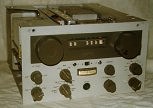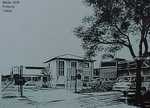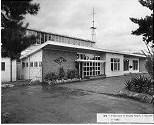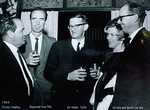EARLY YEARS of WADLEY'S RECEIVERS
(Courtesy of David
Larsen)

In the early 1950s, the only tuneable receiver with the frequency stability
of a crystal oscillator was the Collins 51J (USA) HF receiver. (Click on Photograph to enlarge) The 51J required multiple crystals to provided 'tuneable' coverage over the entire HF frequency range. Dr Wadley's invention relied on a single crystal oscillator to establish multiple 'tuneable' channels that covered the entire HF spectrum.

Dr Wadley made two TRL WADLEY prototype receivers
in the Telecommunications Research Laboratories (TRL)
of the South African Council for Scientific and Industrial Research (CSIR).
Whilst Dr Wadley was working on the Mark II TRL WADLEY prototype Mr Tesseyman (Tess) Peter, who was with the South African Post Office (GPO) at the time, worked alongside him and built an identical receiver for use by the GPO. The first photograph is of the Mark I prototype. (Click on Photograph to enlarge)

In the early 1950s S.M.D. Manufacturing Company (Pty) Ltd (SMD) built six prototype SMD WADLEY receivers under contract to the CSIR. In 1952, as a result of a project initiated by SMD Directors Horace Dainty and Barry Cooke, David Larsen built the 7th prototype SMD WADLEY receiver. It was the first WADLEY RECEIVER prototype that had little resemblance to the earlier WADLEY models as it was intended for amateur radio and commercial use. This receiver is shown the second photograph. (Click on Photograph to enlarge)

Circa 1954 Dr Frank Hewitt (TRL-CSIR) and Mr Tesseyman (Tess) Peter (TRL-CSIR) demonstrated the 2nd prototype TRL WADLEY receiver and 7th prototype SMD WADLEY receiver at the RACAL ELECTRONICS LTD (RACAL) head quarters in Bracknel, Berkshire, England. A licence agreement followed and development of the RACAL WADLEY receiver commenced at Bracknell in late 1954. The team was lead by Geoff Meakes and this receiver became known as the RA17. (Click on Photograph to enlarge). Mr Tess Peter, who was on attachment from TRL-CSIR to TRE Malvern during the period 1952 -1955, worked on the 7th prototype SMD WADLEY receiver at RACAL. Mr Tess Peter may have been mistaken for Dr Wadley and this could have led to the legend that Dr Wadley had once worked for TRE Malvern. To read more about the Racal RA17 and Related Equipment CLICK HERE
|

Circa 1960 Ken Clayton and David Larsen built the first 'all transistor' WADLEY receiver as an amateur radio project. RACAL-SMD Electronics (Pty) Ltd (RACAL-SMD) acquired the rights to the concept and this resulted in the RACAL UK development of the RA217 'all transistor' WADLEY receiver. The RA217 development team was lead by John Dingley. (Click on Photograph to enlarge)
To read more about the RA217 CLICK HERE

In the mid 1960s Dr Wadley built the first prototype of the BARLOW WADLEY 'all transistor' portable receiver. The first prototype was built whilst he was with RACAL-SMD in Pretoria (Click on Photograph to enlarge). The final prototypes were completed at the Barlow Manufacturing Company in New Germany.

It is interesting to note that, in the early 1960s,
the Barlow Group acquired S.M.D. Manufacturing Company (Pty) Ltd (SMD),
that was located at 9 Young Road in Pinetown, (Click on Photograph to enlarge) and moved both the staff and the plant to New Germany where it became know as the Barlow Manufacturing Company Ltd (BMC). Barry Cooke, a founder member and senior director of S.M.D. Manufacturing Company (Pty) Ltd, was appointed Managing Director of Barlow Manufacturing Company Ltd.

LR: Dr Trevor Lloyd Wadley, Raymond Vice (TRL), Dr Webb (NBRI-CSIR), Ursula and David Larsen (RACAL-SMD). Photographs taken 1964/1965 at the Boulevard Hotel, Struben Street Pretoria. Dr Wadley had recently retired from the Telecommunications Research Laboratories (TRL) and joined the board of RACAL-SMD (Pty) Ltd. Circa 1965 RACAL-SMD (Pty) Ltd became Racal Electronics South Africa Ltd. (RESA).
(Click on Photograph to enlarge)
|